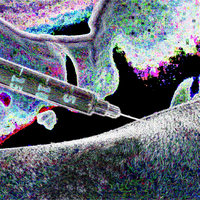| Salbutamol | |
|---|---|
| Esters [] | |
|---|---|
| Salbutamol acetate | |
| Molecular structure via molpic based on CDK |
| Physical properties [] | |
|---|---|
| Molecular mass | 239.31 g/mol [1] |
| Appearance | White to off-white crystalline solid [1] |
| Melting point | 147-149 [1] |
| Solubility | Soluble in ethanol, sparingly soluble in water, and very soluble in chlorform. [1] |
| Predicted LogP | 0.3 [1] |
| Structural Identifiers [] | |
|---|---|
| Molecular formula | C13H21NO3 [1] |
| IUPAC name | 4-[2-(tert-butylamino)-1-hydroxyethyl]-2-(hydroxymethyl)phenol [1] |
| SMILES | CC(C)(C)NCC(C1=CC(=C(C=C1)O)CO)O [1] |
| InChI | InChI=1S/C13H21NO3/c1-13(2,3)14-7-12(17)9-4-5-11(16)10(6-9)8-15/h4-6,12,14-17H,7-8H2,1-3H3 [1] |
| InChIKey | NDAUXUAQIAJITI-UHFFFAOYSA-N [1] |
Salbutamol
Salbutamol (also known as albuterol, Ventoline, Broncovaleas, Albuterol, Salbutamolum, Asthalin, Cobutolin, Salbulin, Salbuvent or Saventol) is a sympathomimetic substance of the phenylethanolamine class.
Chemistry
Salts and Esters []
Salbutamol is typically found in the form of its sulfate, hydrochloride and tartrate salts
or its acetate ester.
Stereochemistry []
(RS)-Salbutamol is a racemic mixture of the optical stereoisomers
Subjective effects
| Anodyne Usernotes [] | |
|---|---|
| 0xea / Salbutamol[sulfate] via Inhaled |
|
See also []
External links []
- Salbutamol / (-)-Salbutamol (Wikipedia)
- Salbutamol / (+)-Salbutamol / (-)-Salbutamol (Wikidata)
- Salbutamol / (-)-Salbutamol (DrugBank)
- Salbutamol / (+)-Salbutamol / (-)-Salbutamol (PubChem)
- Salbutamol / (+)-Salbutamol / (-)-Salbutamol (ChEMBL)
- Salbutamol / (-)-Salbutamol (ChEBI)
- Salbutamol / (+)-Salbutamol / (-)-Salbutamol (Common Chemistry)
- Salbutamol (HMDB)
- Salbutamol / (-)-Salbutamol (KEGG)
- Salbutamol / (+)-Salbutamol / (-)-Salbutamol (UNII)
- Salbutamol / (+)-Salbutamol / (-)-Salbutamol (EPA DSSTox)
References []
National Center for Biotechnology Information. PubChem Compound Summary for CID 2083, Salbutamol. Accessed June 26, 2025. https://pubchem.ncbi.nlm.nih.gov/compound/2083
U.S. Food and Drug Administration; National Center for Advancing Translational Sciences. Salbutamol. UNII: QF8SVZ843E. Global Substance Registration System. Accessed June 26, 2025. https://gsrs.ncats.nih.gov/ginas/app/beta/substances/QF8SVZ843E
 Anodyne
Anodyne